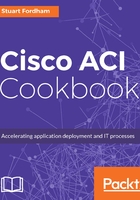
Fabric menu
From the Fabric menu, in the Inventory submenu, we can see our topology:

If we expand the pod out, we can see all of our leaf and spine nodes:

Going through these, we can see our interfaces, routing tables, processes, pools, and rules. One thing to note here is that we have many more routing options with a leaf node than we do with a spine node:

Under the Fabric Membership option, we have a list of our leaf and spine nodes, which shows us the serial numbers, ID, name, model, role, and assigned IP address. It also gives us the certificate information, so we know that SSL is healthy and IFM can function.

The last three options in this menu are for the nodes we may be having issues with, whether they are currently unmanaged, unreachable, or disabled and decommissioned.
The other options in the Fabric submenu are our policies. Here, we can set up callhome policies, monitoring, troubleshooting, spanning tree and VPC policies, whether we want to have CDP turned off or on, and various layer-2 policies. Many of these options have three options; take LLDP for example. We have an option for LLDP-OFF (disabled), LLDP-ON (enabled), and default (Receive State is enabled, and Transmit State is enabled). Similarly, for CDP we have CDP-OFF (disabled), CDP-ON (enabled), and default (where the Admin State is Disabled).